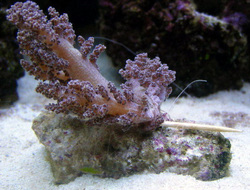Colt Coral

Here we are taking a look at a fairly commonly found and easily
kept soft coral, the Colt coral of the species Cladiella. These
corals are often obtained by beginners and generally thrive in aquarium
conditions. As they are largely photosynthetic and rely on the
products of their
zooxanthellae they generally require fairly good lighting, i.e.
multiple T8/T5s or metal halide lighting. However they may also feed on
plankton in the water column so make sure you also use an appropriate
coral food to aid their growth.
The first thing
worth knowing with this coral is that periodically it may retract its
polyps and a mucus film may cover the coral. This is believed to be
a normal thing and helps aid the coral fight against algae growth on the
coral tissue and to also help coral growth, so if this happens to yours,
don't be too alarmed!
The next thing to
bare in mind is that the Colt coral, like other soft corals such as
Sarcophyton sp, is that it may release a level of toxins into the water
that may restrict the growth of stony corals, so bare this in mind if you
are aiming to frag both soft and hard corals in the same time.
Having said this most people experience very little effect due to mixing
soft and hard corals, which may well be due to the wide use of carbon to
remove chemicals and toxins from the water, so it goes without saying that
carbon is a well worth form of filtration to employ in your reef or
fragging tank.
Now onto the propagation, using a method which is becoming more popular in the fragging of soft corals. Using a cleaned Stanley knife or craft knife blade cut your selected piece of the coral "tree" cleanly and swiftly. Now you just need a cocktail stick to pierce the coral tissue carefully about 1cm from the base, giving you something to easily tie down to a fragment of rock using fishing line or elastic bands. Once you have done this then place the coral in an area of relatively low flow so that the coral tissue does not risk being torn or damaged whilst the stick is in place.
That's it! A really easy one to frag, and hopefully we have shown you that propagating your own corals isn't a difficult or time-consuming task. Just remember not to be scared of the prospect of damaging your coral and killing the colony as this is very rare. Also make sure you keep a close eye on the attachment of the coral to your rock fragment. Sometimes it may take what seems like a while to grow onto the rock, but you can be rest assured that if your water quality is good and the coral has been previously consistently healthy then it should never present a problem.
When you are happy with your frag and feel it has sufficiently attached and is looking healthy, pull out the cocktail stick slowly and cleanly, and there you have it. A new colony of Colt coral to place somewhere else in your reef, swap with your reef-keeping friends or trade in at your local fish shop for something else!
Now onto the propagation, using a method which is becoming more popular in the fragging of soft corals. Using a cleaned Stanley knife or craft knife blade cut your selected piece of the coral "tree" cleanly and swiftly. Now you just need a cocktail stick to pierce the coral tissue carefully about 1cm from the base, giving you something to easily tie down to a fragment of rock using fishing line or elastic bands. Once you have done this then place the coral in an area of relatively low flow so that the coral tissue does not risk being torn or damaged whilst the stick is in place.
That's it! A really easy one to frag, and hopefully we have shown you that propagating your own corals isn't a difficult or time-consuming task. Just remember not to be scared of the prospect of damaging your coral and killing the colony as this is very rare. Also make sure you keep a close eye on the attachment of the coral to your rock fragment. Sometimes it may take what seems like a while to grow onto the rock, but you can be rest assured that if your water quality is good and the coral has been previously consistently healthy then it should never present a problem.
When you are happy with your frag and feel it has sufficiently attached and is looking healthy, pull out the cocktail stick slowly and cleanly, and there you have it. A new colony of Colt coral to place somewhere else in your reef, swap with your reef-keeping friends or trade in at your local fish shop for something else!
